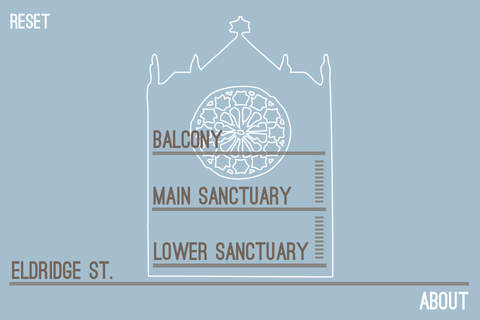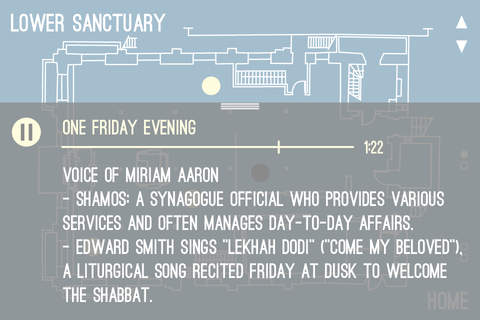I recently met with Hanna Griff-Sleven, a professor who teaches a course called “Oral Histories of the Lower East Side” in Eugene Lang College at The New School. She works at the Museum at Eldridge Street, which is a beautiful synagogue that was brought back to life and made into a museum after decades of disrepair.
Hanna worked on a native iPhone application that is similar to Storyportal. The app is called “Storywalks” and was made to record the history of the Museum at Eldridge Street. As the user walks through the space, they can first choose a level of the building to start in, either the balcony, main sanctuary, or lower sanctuary. Then the users sees the blueprint of the floor they are on with a number of dots that they can click on. Each dot has a different story associated with it and the story has to do with that specific location in the sanctuary. When the dot is tapped, the user can hear the story associated with that specific location.



I felt that the Storywalks app was incredibly successful. After spending about an hour listening to many touching, personal stories about the space, I really felt a great connection to the people that prayed there.
I went to Hanna for advice on how best to gather interesting oral histories from New Yorkers. Hanna had a number of great suggestions and tips for approaching the story collection portion of the project. My main take-aways from our conversation were to develop a clear, concise elevator pitch of my project, to personally interview people to get the best storytellers and to focus on the way I prompt storytellers.
Elevator Pitch
First off, Hanna said that I needed to come up with a simple way of explaining my project that everyone will quickly understand. She said that it should be one paragraph, like a 30-second elevator pitch. I’m definitely working on a clear and succinct way of explaining the project to other people and will continue to focus on this.
Get Personal
Hanna suggested that I speak with people personally to collect stories. She suggested that I center my project around a certain location or locations and actually interview in these locations. A good way to do this is by speaking with business owners of well-known New York City establishments like Roni-Sue’s Chocolate Shop on Forsyth Street or The Bitter End Coffeehouse near NYU.
It’s All About the Prompt
Hanna explained that the types of stories that I gather will be completely dependent on the way I prompt people. Hanna said that I should ask very specific questions about these specific locations. She suggested that I research the history of these different areas. This way, I will know specific facts about the locations I focus on – like events that took place there or the different populations living there – and can come up with more effective prompts because more specific prompts elicit better stories.
Hanna also thought that focusing on Sports, Music and Foodie Culture of New York City would probably inspire some fun and interesting stories. She explained that a lot of her family members are very interested in NYC sports history and have great memories of the Dodgers winning in 1968. She also suggested that people might have cool stories about the Beatles at Shea Stadium in 1965. She also pointed to Mimi Sheraton’s Food Stories and Melissa Clark from the NYTimes food page.
Hanna also suggested a number of specific venues, businesses, and people to speak with about the project. These include Roni-Sue’s Chocolate Shop on Forsyth Street, Essex Street Market, The Chelsea Hotel, CBGBs in the East Village, Café Carlyle on 76th St, The Bitter End Cafe in Greenwich Village, The Apollo Theatre, Lincoln Center.
